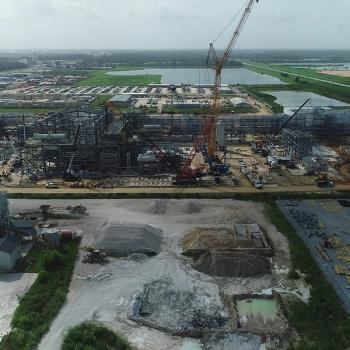
Latest combined cycle plants: compact models, higher efficiencies
The combined impact of the gas and steam turbines was discussed in the
Single unit combined cycle plants range from 400 MW (60 Hz at 3600 RPM) to 670 MW (50 27Hz at 3000 RPM), depending on the gas turbine design (simple or reheat). They already have cycle efficiencies just under 60 % LHV and at last a German design by Siemens has an advanced gas turbine firing at 2900 o F and coupled to a 1112/1112 o F (600/600 o C) HRSG and a new high temperature steam turbine recently has been tested, to produce 578 MW net power at 60.75 % efficiency to become a world record.
The latest GE Frame 7 and 9 "H" combined cycles to be installed will produce 400 MW and 520 MW respectively at a combined cycle efficiency of 60 %. GE recently announced in Paris, France a new F series 510 MW (50 Hz) combined cycle called the “FlexEfficency” 50, with a combined cycle efficiency of 61 % using air cooling instead of steam. A 60 Hz version will be available in the near future in North America. A higher efficiency design is in the works according to GE. The Flex 50 will have a new 1100 /1100 o F side exhaust steam turbine and a new HRSG to match. Alstom's GT 24 and 26s (now called the KA24 and 26s) also will have a combined cycle efficiency of 60 % but have the advantage of higher part load efficiency due to the reheat feature. MHI likewise has its new "J" machines about ready to go.
Siemens’ HRSG and more compact models
Progress is still being made in the HRSG business as can be verified by the new Siemens’ HRSG. Solar headed by Tom Duffy under a DOE contract tested a once through boiler and topping steam turbine to operate at 1500 o F and 1500 psia throttle conditions in 1994. Little US interest was shown and the program was dropped in 1996. Apparently, Siemens continued work on higher throttle temperatures for steam turbines and HRSGs.
Early work on HRSGs was done by the heat exchange people catering to the petro chemical industry. These early units applied extended surface tubing for the boiler tubes and some had forced circulation while others stuck to natural circulation. Later on, as the market grew, the boiler people got into HRSGs and extended surface heat transfer as well as low gas turbine back pressure. GE and Westinghouse pushed them along in the US to come up with the modern HRSGs used today. A number of once through boilers are in service. These boilers are more compact and have no steam drums.
Considerable jump in efficiency and power output
The increase in industrial gas turbine firing temperature up to 3000 o F, an increase of some 600 o F, has been the most significant advancement in ten years in terms of both cycle efficiency and power output. This jump forward has made it possible through the introduction of ceramic TBCs that actually breathe to form transpiration cooling. It is critical to keep the bonding layer at a temperature no greater than 2100 o F to prevent bonding destruction and exfoliation.
Curtis-Wright in the mid 70s pioneered this approach to cooling and ran tests up to 2500 o F, an unheard of temperature at the time, on a blade design having woven high temperature material on the outer surface to pass the cooling air. Sylvester Lombardo published an ASME paper on the tests. In recent years, evidence indicates that transpiration cooling has been perfected using porous ceramic TBCs that allows the cooling air to first cool the inside of the blades by conventional methods and then to excrete the heat through the weep holes to the many pore like openings of the ceramic material to blanket the entire outer surface of the blading. Cooling air is conserved and up goes the turbine firing temperature, power output and cycle efficiency.
This new breakthrough is challenging the need for the “H” steam blade portion of the cooling technology introduced a few years ago by GE. Little has been said or released about the new air cooling by the press and how it is accomplished, but yet here it is and it is only sparsely mentioned. Even GE is switching back to air cooling for its latest “FlexEfficiency” 50 and 60 (9FB and &7FB) combined cycles. All the gas turbine industry appears to be switching to this new cooling system for turbine blades. Some are retaining steam cooling for the hot fixed parts of the gas turbine.
Ivan G. Rice was past chairman of the South Texas Section of ASME (1974 - 75), past chairman of the ASME Gas Turbine Division (now IGTI) (1975 - 76). A Life Fellow Member of ASME and Life Member of NSPE/TSPE, he has authored many articles and ASME papers on gas turbines, inter-cooling, reheat, HRSGs, steam cooling and steam injection.
Newsletter
Power your knowledge with the latest in turbine technology, engineering advances, and energy solutions—subscribe to Turbomachinery International today.




